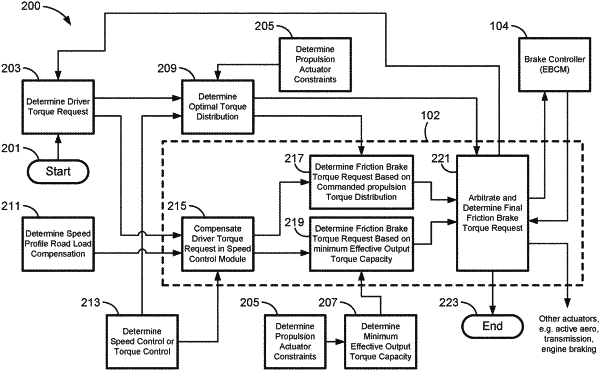| CPC B60L 15/2009 (2013.01) [B60T 8/1701 (2013.01); B60W 10/18 (2013.01); B60W 10/184 (2013.01); B60W 30/09 (2013.01)] | 20 Claims |

|
1. A method of operating a motor vehicle, the motor vehicle including a plurality of road wheels with a first wheel and a second wheel, first and second axles, a friction brake system, a powertrain system, and an input device operable to receive control inputs from an operator of the motor vehicle, the method comprising:
receiving, via a vehicle controller from the operator via the input device, a vehicle control command with an associated torque request for the motor vehicle;
determining, via the vehicle controller, a propulsion actuator constraint limiting a brake torque capacity available from a powertrain actuator of the powertrain system;
determining, via the vehicle controller using the propulsion actuator constraint and the torque request input by the operator, a propulsion brake torque distribution for the road wheels of the motor vehicle and a maximum brake torque capacity for the powertrain actuator, the propulsion brake torque distribution including a first propulsion torque of the powertrain actuator allocated to the first axle or the first wheel of the motor vehicle and a second propulsion torque of the powertrain actuator allocated to the second axle or the second wheel of the motor vehicle;
determining a first friction brake torque request using the propulsion brake torque distribution, the torque request, and a vehicle control mode of the powertrain system;
determining a second friction brake torque request using the maximum brake torque capacity, the torque request, and the vehicle control mode;
determining a final friction brake torque command by arbitrating between the first and second friction brake torque requests based on a brake torque optimization decision; and
transmitting, via the vehicle controller, the final friction brake torque command to the friction brake system to apply a friction-based brake torque and a final powertrain brake command to the powertrain actuator to apply a powertrain actuator-based brake torque.
|